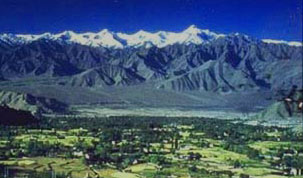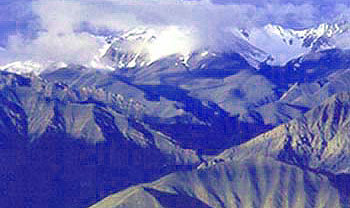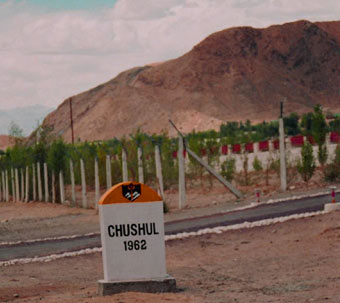|
Travelogues Adventure at Pangangsto from Leh to Chusul
|
|||||
In July 2004, I decided to challenge my newly acquired Mahindra Scorpio on the way from Manali to Chushul via Leh. I took pains to pack for the trip with skills acquired earlier while driving through Arabian deserts. The journey from Dehradun to Manali was uneventful though very interesting. Crossing over from Uttaranchal to Haryana and then the Union Territory of Chandigarh on to Punjab and then in to Himachal along the mighty Beas river familiarises you with the diversity of topography and the variety of cultures. The journey to Leh through Rohtang pass with a night halt at Pang Army Transit camp, was also very enjoyable except for the inclement weather and chilly dusty fast winds at Pang. By 4 o'clock we were nestled in our comfortable rooms with modern amenities courtsey Indian Army! To our surprise Leh was warm and we were sleeping with the windows open and no body wraps. After a week long visit to the surrounding monasteries, the homes of some locals and a brief visit to the famous Nubra valley, we decided to move towards Chushul. |
Factfiles • J&K Overview • Ladakh • H.P. Overview
Travelogues
Adventure | ||||
I did not switch off the engine to avoid water entering through the exhaust. This was a trick I had learnt from an earlier grounding experience. As time passed the water level started rising as the sun rose to its zenith melting more of the glacial waters that poured into the stream. We relieved the car of all load, including the passengers in order to lighten it, with the sole exception of the lady in the foul mood. We tried to dig the wheels out with our bare hands and even tried to divert water from flowing directly towards the car by making sand bars covering the length of the car, but nothing worked.
Our main worry was now to extricate ourselves from this predicament. Thoughts of the loss of the new car decked with leather seats and the three screen DVD etc etc., had merged into the backdrop. I pitched the five man tent on dry and high ground and placed all our belongings inside, in order to anchor it to the ground as the wind velocity was very strong and would uproot it and take it to the lake. Even then, some of us had to remain inside all the time. My wife was getting increasingly more panic-struck.
I happen to carry a SAT phone (Thuraya), the battery of which I had charged fully the last night at Leh. I fished it out of my bag and tried the phone of the person in Leh who could help us out of this mess. Lucky first time! We managed to connect immediately and were assured that help would start immediately from both ends and we should use the one that reached us first. We were also told that it would take some time and that we must not panic. I also informed our saviours that in order to conserve the battery, I would keep the phone off and would contact them only if need be. It took about 5 hours for help to arrive from Chushul. In the meanwhile every time my wife would spot a wild yak grazing miles away she would think it was a vehicle to the rescue and would get more and more disappointed. The Gurkha soldiers came in a two and a half ton truck and took out a manila rope. I was aghast at this. From earlier experience I had seen fabric and steel tow ropes of over two tons rating, snapping apart in less demanding condtions than this. Here we were two tons weight and burried. One of the soldiers got in to the water and dug underneath for the tow hook which he attached with the rope and tied it to the truck. I could not believe my eyes as the vehicle moved out of the stream in seconds. With apprehension I pressed the remote start and the engine purred like a cat. With trepidation, I opened the door amd to my utter surprise there was not a drop of water in the car. Compliments to Mahindra Scorpio for being immersed in water for over 7 hours to come out completely dry. We proceeded happily on our onward journey to Chushul. With its spectacular scenery. At over 14,000 feet. it is a small village in a narrow valley about 25 miles long and 4 miles wide, the surrounding mountains rising to over 19,000 feet. On the north is the Pangong Tso, a hundred mile long saltwater lake, and close by, in a break between the mountains, is the splendid Spanggur Tso Lake. At Chushul, the Kumaon Regiment had fought a valiant battle defending our borders in 1962. A monument in remembrance says, "How can a man die better than facing fearful odds for the Ashes of his Fathers and the Temples of his Gods."
Photo Credit: Capt Alok Sharma
|
|||||
Editor: Romola Butalia (c) India Travelogue. All rights reserved. |
|||||
 At 7 am we started from Leh, arriving at Pangantso around 10am. It is beyond me to describe the beauty here. All I can say is that I have never witnessed so many hues of blues at one place except in the plumage of a peacock or a male Monal. After brunch and a long power boat ride in to the lake, thanks to the Indian Army, we proceeded on an ‘assault to Chushul’. Ha! Since, there is no road to Chushul, one has to
drive through gravelled passages with some one to three feet of water
coming down the hills from the melting of glaciers on the right. On the left is the mighty lake itself. We are talking of an area
where average height is above 15,000 feet above sea level and one has
to drive for tens of miles in these conditions. The lake is about 150 km long and on an average about 20-40 km wide, with the shred boundary of India and Tibet running through it. An ice age water body, the waters are brackish , the lake is
extremely deep though the slope from the banks is gradual and the visibility
to the bottom instills cold comfort to the driver.
At 7 am we started from Leh, arriving at Pangantso around 10am. It is beyond me to describe the beauty here. All I can say is that I have never witnessed so many hues of blues at one place except in the plumage of a peacock or a male Monal. After brunch and a long power boat ride in to the lake, thanks to the Indian Army, we proceeded on an ‘assault to Chushul’. Ha! Since, there is no road to Chushul, one has to
drive through gravelled passages with some one to three feet of water
coming down the hills from the melting of glaciers on the right. On the left is the mighty lake itself. We are talking of an area
where average height is above 15,000 feet above sea level and one has
to drive for tens of miles in these conditions. The lake is about 150 km long and on an average about 20-40 km wide, with the shred boundary of India and Tibet running through it. An ice age water body, the waters are brackish , the lake is
extremely deep though the slope from the banks is gradual and the visibility
to the bottom instills cold comfort to the driver.

 The engine was running for almost an hour. Suddenly it
struck me that I could attach the inlet end of the air jack that I was
carrying to the exhaust and tie it to the roof top to avoid water
entering the exhaust. I located the exhaust pipe end with
little bit of digging and attached the hose firmly, tied this to the roof top and
switched off the engine. By this time the water level was slightly higher
then the windows and the car was in imminent danger of being washed away to the deeper part of this huge lake.
The engine was running for almost an hour. Suddenly it
struck me that I could attach the inlet end of the air jack that I was
carrying to the exhaust and tie it to the roof top to avoid water
entering the exhaust. I located the exhaust pipe end with
little bit of digging and attached the hose firmly, tied this to the roof top and
switched off the engine. By this time the water level was slightly higher
then the windows and the car was in imminent danger of being washed away to the deeper part of this huge lake.
 The last habitation was at least 25-30 km away and Chushul was still five to seven hours away. At an altitude of 15,000 ft plus, with no vegetation and depleted oxygen, my wife was also having some breathing problem. We were carrying enough oxygen and breathing apparatus. But walking in this terrain to get help seemed out of the question. This area is of strategic importance and is close to the international border with our
two neighbours - one of them sitting not more then a km from our location as
the crow flies. There was no GSM or local cell phone network in the area (Leh
has cell phone coverage but only within a radius of 25 km.)
The last habitation was at least 25-30 km away and Chushul was still five to seven hours away. At an altitude of 15,000 ft plus, with no vegetation and depleted oxygen, my wife was also having some breathing problem. We were carrying enough oxygen and breathing apparatus. But walking in this terrain to get help seemed out of the question. This area is of strategic importance and is close to the international border with our
two neighbours - one of them sitting not more then a km from our location as
the crow flies. There was no GSM or local cell phone network in the area (Leh
has cell phone coverage but only within a radius of 25 km.)